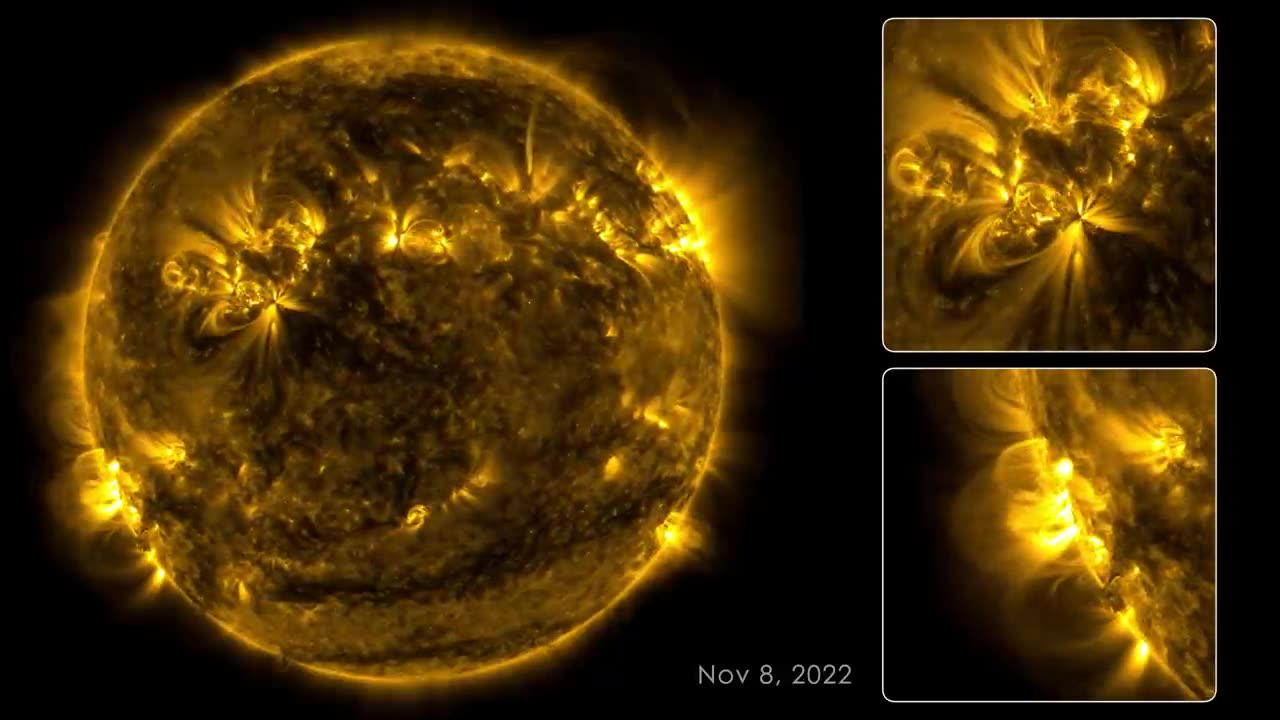Premium Only Content

The Sun
133 days on the SUN.
Characteristics of the sun
The sun resides some 26,000 light-years from the Milky Way's center, in a tendril of our home galaxy known as the Orion Arm. Every 230 million years, the sun—and the solar system it carries with it—makes one orbit around the Milky Way's center. Though we can't feel it, the sun traces its orbit at an average velocity of 450,000 miles an hour.
The sun formed more than 4.5 billion years ago, when a cloud of dust and gas called a nebula collapsed under its own gravity. As it did, the cloud spun and flattened into a disk, with our sun forming at its center. The disk's outskirts later accreted into our solar system, including Earth and the other planets. Scientists have even managed to see these planet-birthing disks around our sun's distant young cousins.
Our home star is a yellow dwarf, a medium-size variety that's fairly common in our galaxy. The label “yellow” is misleading, though, since our sun burns a bright white. On Earth, the sun can take on warmer hues, especially at sunrise or sunset, because our planet's atmosphere scatters blue and green light the most.
From our perspective, “dwarf” might not be the best word for our sun, either. At about 864,000 miles (1.4 million kilometers) wide, the sun is 109 times wider than Earth, and it accounts for more than 99.8 percent of the solar system's total mass. If it was a hollow ball, more than a million Earths could fit inside it. But the sun isn't hollow: It's filled with scorching gases and soups of electrically charged particles called plasma. The sun's surface temperature is about 10,000 degrees Fahrenheit (5,500 degrees Celsius), and it's 27 million degrees Fahrenheit (15.5 million Celsius) at the core.
Deep in the sun's core, nuclear fusion converts hydrogen to helium, which generates energy. Particles of light called photons carry this energy through a spherical shell called the radiative zone to the top layer of the solar interior, the convection zone. There, hot plasmas rise and fall like the ooze in a lava lamp, which transfers energy to the sun's surface, called the photosphere.
It can take 170,000 years for a photon to complete its journey out of the sun, but once it exits, it zips through space at more than 186,000 miles a second. Solar photons reach Earth about eight minutes after they're freed from the sun's interior, crossing an average of 93 million miles to get here—a distance defined as one astronomical unit (AU).
Out beyond the sun's photosphere lies the atmosphere, which consists of the chromosphere and the solar corona. The chromosphere looks like a reddish glow fringing the sun, while the corona's huge white tendrils extend millions of miles long. The chromosphere and corona also emit visible light, but on Earth's surface, they can be seen only during a total solar eclipse, when the moon passes between Earth and the sun.
#Sun
#NASA
#NASAMission
#SolarSystem
Follow 👇
https://rumble.com/user/Kami64
-
 1:38:36
1:38:36
Glenn Greenwald
9 hours agoProf. John Mearsheimer on Israel's Destruction of Gaza, Trump Admin Attacks on Universities & Speech, Yemen Bombings, Tariffs & Competition with China; Plus: Q&A with Glenn | SYSTEM UPDATE #434
136K83 -
 8:00:00
8:00:00
SpartakusLIVE
1 day agoThe MACHINE is back after a RESTFUL 4 hours of sleep
141K6 -
 4:09:39
4:09:39
I_Came_With_Fire_Podcast
14 hours agoTARIFF TAKEOVER | REDCOATS 2.0 | DOGE FINDS SOMETHING HORRIBLE
29.9K13 -
 LIVE
LIVE
Eternal_Spartan
6 hours agoLive at 9pm Central! Come Hang Out w/ a USMC Vet Playing HALO! Can't Wait to See Everyone!!
871 watching -
 5:09:12
5:09:12
EzekielMaxwellVT
9 hours agoVTuber/VRumbler - Vampire The Masquerade - Listening to the voices in Jo's head
16.6K -
 6:48:45
6:48:45
Welsh Girl
8 hours ago🔴 Minecraft - Finding the Ender Dragon - DAY 7
26.1K3 -
 4:00:33
4:00:33
SynthTrax & DJ Cheezus Livestreams
1 day agoFriday Night Synthwave 80s 90s Electronica and more DJ MIX Livestream Trip-Hop SPECIAL EDITION
55.7K1 -
 4:03:27
4:03:27
FusedAegisTV
12 hours agoRumble Smackdown! #001 Street Fighter 6 $500 Online Tournament
82.6K8 -
 55:58
55:58
BonginoReport
10 hours agoCan Trump Make TikTok Great Again? (Ep. 20) - Nightly Scroll with Hayley Caronia - 04/04/25
154K83 -
 5:09:35
5:09:35
Jorba4
6 hours ago🔴Live-Jorba4- COD WARZONE- VERDANSK FRIDAY. Hot drops W/ XxXAztecWarrior and Lumpy Potato X2
33.4K